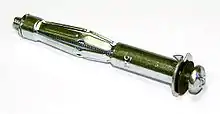Molly (fastener)
A molly or molly bolt, often misspelled moly,[1] is a formerly trademarked[2] name for a specialized screw fastener that would reliably fasten objects to plaster or gypsum board hollow walls. Larger sizes permit reasonably heavy objects, such as shelving, flatscreen-TV mounts or central-heating radiators to be attached to drywall in locations where there is no stud behind the drywall. For heavy objects, multiple molly bolts may be required.

History

The molly bolt was patented in 1934 by George Frederick Croessant.[3] Although his patent acknowledges that expandable fasteners of this general kind were already known, Croessant's patent is intended to provide "an improved and adequate anchoring grip that may be retightened if necessary and that will permit repeated withdrawals and reengagements of the associated bolt." The same year, Croessant also registered the trademark "MOLLY".[1]
Attaching
The fastener is an anchor, an expandable sleeve that slides into a hole drilled into the wall. A lip wider than the hole prevents it from falling behind the wall and rotating when being compressed. A machine screw is then screwed into the sleeve, causing the anchor to bend, expand, spread and grip against the inside of the drywall.[1]
Mollies come in various diameters and "grip lengths" for different drywall thicknesses and to support different loads.[1]
See also
- Toggle bolt, a bolt that has hinged flaps or wings
References
- Koenigsberg, David (2003). Handyman's Handbook: The Complete Guide to Starting and Running a Successful Business. McGraw-Hill Professional. p. 111. ISBN 0-07-141670-6.
- United States Patent and Trademark Office
- United States Patent No. 2,018,251